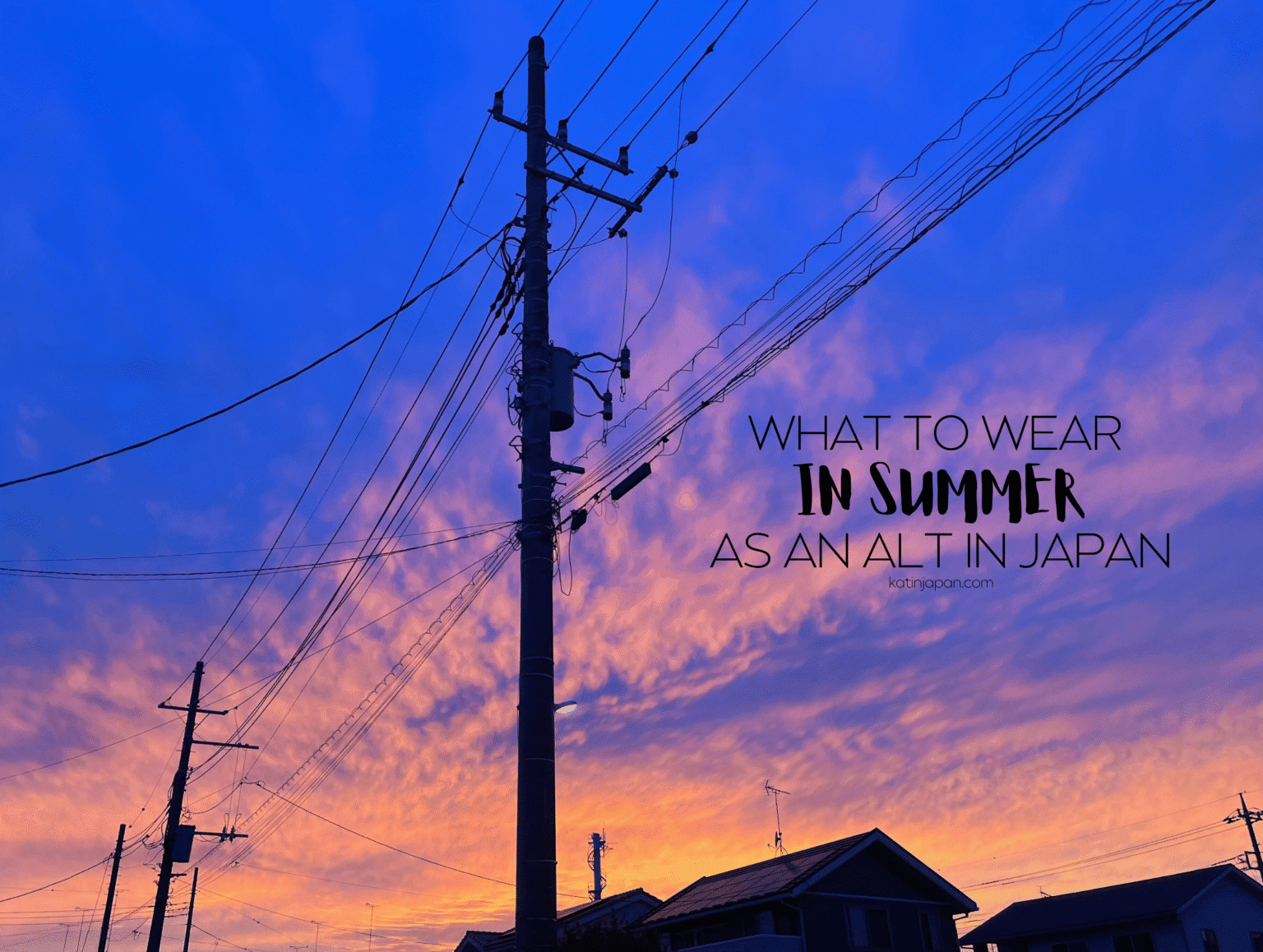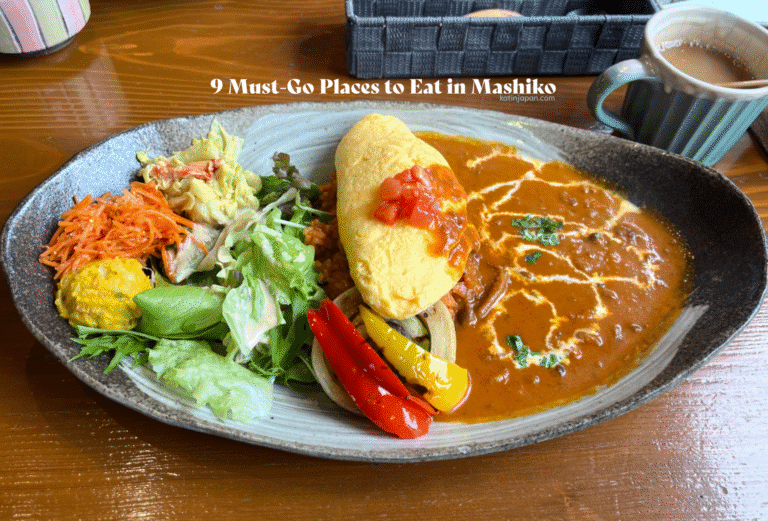It’s no secret that summer in Japan is meltingly hot. Humid air meets blazing sun, and in rainy season 梅雨 (tsuyu), the moist air kicks everything up a notch.
Soon you’ll find yourself sweating through your clothes if you don’t try these tips on what to wear as an ALT in Japan!

For information on what to wear for school events like graduation or opening and closing ceremonies, check my How to Dress for Ceremonies as an ALT post!
And if you’re wondering what to wear or bring to Japan in the summer, look no further than my Quintessential Japan Packing List.
What to Wear as an ALT in Summer

There’s an art to dressing appropriately for each season in Japan, and even more so when you’re working here.
Luckily many businesses operate on Cool Biz (クールビズ) in the summer, so you can wear short sleeved button-ups and polos no problem.
Many retailers like Uniqlo, Shimamura, Aeon, etc. also sell great undershirts for wicking sweat.
But being an ALT is complicated. Unlike many Japanese workers, we aren’t always accustomed to the heat, and we may have other conditions to cover- like body odor or tattoos.
You’ll want to refer to your employer and BOE (Board of Education) guidelines, but this is a guide for those who worry about what to expect – like me.
If you’re unsure of what to wear or buy for summer, enjoy these tips. But remember, you can take a look at how everyone in the staffroom dresses for reference too!
Summer Ceremonies
After summer vacation, students and teachers return to school with a ceremony. These are often held in gymnasiums with little to no air conditioning.
Therefore schools tend to be less strict about formal wear during the summer. A white short-sleeved blouse or button-up and dark pants will should suffice in the summer.
My school tends toward casual, with most teachers wearing their day-to-day wear at the opening ceremony. (始業式 shigyōshiki)
If you’re concerned about what to wear, check out my How to Dress for Ceremonies in Japan post for an in-depth look.
Womenswear
I consider myself nonbinary and personally feel comfortable in both women’s and men’s business styles. However, there’s a larger range of styles available in women’s workwear.
You can wear short-sleeved blouses or button-ups, and it’s more acceptable here to dress fashionably. This gives us some wiggle room to stay cool while still looking relatively cool.
You can wear wide-legged pants, which are thankfully in fashion and therefore widely available, or even long breezy skirts. I would caution against tight pencil skirts or anything too short however, so check your employers’ guidelines.
Many teachers in my school wear blouses that are functionally tank tops with some sheer ruffles on the sleeves. It’s cute and good for the weather. Blouses with some transparency over a simple camisole are popular too.
For more important occasions like assemblies, they may wear suit skirts and hose, but will drop the suit jacket.
Acceptable Summer Workwear for Women:
- Flowy blouses (any sleeve length)
- Tank top / short sleeve blouses
- Light summer sweaters
- Full length dresses
- Flowy / maxi-midi skirts (past the knee)
- Wide-leg trousers or gauchos
Menswear
The simplicity of men’s summer wear is *chef’s kiss*. In summer you can wear short-sleeved polos, cool-biz button-ups, and possibly even… shorts??
This will depend entirely on your BOE and dispatch company, of course, but gym teachers will often be caught wearing shorts, and if you work with younger kids you may be able to on occasion. Just check your guidelines first.
Other male teachers tend to wear cool biz slacks and polos or short-sleeved button-ups. Suit jackets basically become obsolete even for assemblies in the summer.
Acceptable Summer Workwear for Men:
- Short sleeve button-up shirts
- Polo shirts
- Long sleeve button-up shirts with sleeves rolled up
- Cool biz slacks (can be found at Uniqlo, Aeon, etc.)
- Khakis
- Wide-leg trousers
- Summer sweater vests
Important Notes
Feel free to mix and match these options. I’ve split them into womens and menswear for simplicity, but clothing is all about what makes you feel comfortable and professional!
By the way, a general rule of thumb is to never wear jeans. For some reason, jeans are too California-core, aka way too casual for business here. Even at schools.
Also, try to avoid wearing tracksuits outside of outdoor activities. Most teachers are in charge of clubs at the end of the day, and will swap to comfortable clothes as such.
For indoor shoes, black tennis shoes, loafers, flats, etc. are all acceptable. Heeled shoes only appear at big events or assemblies and are usually short kitten heels with a closed toe.
Outdoor activities

For summer camps, sports days (undōkai 運動会), and other outdoor activities, the dress code tends to be less strict.
Teachers can wear short-sleeves or polo shirts, work out pants, and even basketball shorts and capris.
Sweat wicking work-out clothes that aren’t tight-fitting, like joggers or straight-leg athletic pants, are good. T-shirts and light airy jackets are also used to cut UV exposure.
Many teachers have a set of windbreaking tracksuits that they break out just for these sports days.
And most if not all of the female teachers also love to sport UV sleeves that with their short-sleeves. Ironic but effective.
Sunglasses and wide-brimmed hats are recommended, and don’t skimp on the sunscreen!
Tip and Tricks to Keep Cool
Regardless of what you try, sweating is inevitable in the heat and humidity of Japan.
Luckily, working in a classroom isn’t the same as walking a day in the heat of Tokyo’s concrete jungle. Here are some tips to stay fresh and cool.
Natural fabrics
- Fabrics like cotton, linen, and other natural fibers are good for wicking moisture and providing airflow to keep you cool. I’m a fan of Cotton Lawn myself. Hobonichi even makes some of their planner designs with cotton lawn fabrics!
Undershirts
- This goes without saying but… wear them. Trust me. The undershirt will take the hit of sweat, keeping your outer layer dry (mostly).
Hydration
- Keep a bottle of ice water at your desk, and consider bringing it with you to the classroom as well. Though you may not be able to drink during class, take sips in between, especially on hot, busy days where you can’t get back to the staffroom!
Cooling wipes
- Teachers and students alike use these often. Give ’em a try. Just be aware some use aluminum like antiperspirants, so check the label. If you can, try to use unscented 無香性(mukousei) ones! Bioré and Kosé are popular brands for these.
Cooling spray
- Like the wipes, you can find these in large grocery or department stores like Aeon pretty easily. Some are for your skin, while others are for your clothes. Both are typically made with menthol for that cooling sensation. Ice King and Shirt Cool are notable spray brands.
Deodorant
- I’ve finally found it in Japan. They sell deodorants/antiperspirants now at most pharmacies and grocery stores. A popular and, from what I hear, effective brand is Deonatulle (デオナチュレ).
Mini fans
- At first I thought these were a stupid thing to carry around, but I’m a believer now. These little wonders help wick your sweat even when it’s humid. You can keep them on your desk in the staffroom. They aren’t perfect, but it’s better than nothing!
What I wear as an ALT in Japan
When I dress for work I keep three things in mind – and this goes for any job. Style-wise I try to maintain a balance between grandpa, mailman, and college art professor.
Suitability
- This includes basic appropriateness for the job. Not showing too much skin or trying to achieve “office siren” levels of fashion.
- Dressing in accordance with what you’re doing. Are you at an office job? Painting murals? Playing with kids at camp? Meeting a new principal? All of these situations have different requirements, so keep it in mind when choosing your wardrobe or outfit of the day.
- Have at least one go-to outfit for common occasions like assemblies or outdoor days.
Comfort
- I want to be comfortable in my clothes which means comfy fabrics, few tags and zero scratchy things.
- Being able to move freely even in formal-wear.
Ease
- Having a few pieces that all fit together saves me time and energy in the morning.
- Getting dressed in the morning shouldn’t be a chore.
Check out my Summer work-wear in my Summer OOTD tiktok below!
Working summer into this equation is where things get tricky. Whereas you can wear layers and sweaters in the spring, fall, and winter, summer calls for some finesse.
Summer means light, breezy fabrics like linen, cotton, and other natural fibers. A bonus is these natural fibers tend to be opaque, especially with a pattern, which helps obscure tattoos. And luckily Japan is fond of 1/2 and 3/4 sleeves.
So whenever I see a 100% cotton or linen shirt with 3/4 sleeves, I pick it up. Second hand stores like 2nd Street are a lifesaver for me because they have so many good choices for less than ¥1000 (~$7). Swoon.
It’s also a life-saver to invest in undershirts made with sweat-wicking fabric like airism (not sponsored, but I wish). I don’t mind a built in bra camisole either, but it’s up to you.
Capsule Wardrobes
Ever since I started working in my teens, one priceless piece of advice I received has been to curate your own work “uniform”.
Consisting of pieces that all work together to create timeless, fashionable, or utilitarian daily outfit, your capsule wardrobe should have clothing that works for you day in and out.
The secret is, I don’t just have one capsule wardrobe. I have three.
Essentially, I have one capsule wardrobe per season, based on the temperature (spring and fall are together). This allows me to own less clothes while still being efficient and cute.
Staples in my summer work wardrobe are:
- Dress Shirts/Blouses (3/4 sleeves or loose-fitting sleeves to roll up)
- Airism undershirts
- Skinny and wide-leg slacks (Same throughout the year)
- Skirts
In the transition seasons, fall and spring, I cycle in sweaters and cardigans. When winter hits, I layer up with heat tech and wool sweaters and socks.
Searching for Clothes in Japanese
Japanese has its own lexicon for clothing, and some of the differences may surprise you.
While we call any shirt -business or not – a “shirt” in English, the word シャツ (shatsu) refers specifically to button-down business-appropriate shirts. They may also be called ワイシャツ(waishatsu) meaning a white button-down.
And while pants or slacks may be referred to as パンツ (pantsu) on sites like Zozotown or Uniqlo, keep in mind that “pantsu” still means “underwear” to most Japanese speakers.
Here’s a breakdown of some common terms for searching business-wear online or in-store.
Tops トップス toppusu
- Dress shirts
- シャツ (shatsu)
- ドレスシャツ (doresushatsu)
- ワイシャツ (waishatsu)
- Blouses ブラウス (burausu)
- Polo Shirts ポロシャツ (poroshatsu)
- “Cut and Sew” Garments カットソー (kattosō)
- Sweater セーター (sētā)
- Sweater Vest ニットベスト (nittobesuto)
Bottoms ボトムス (botomusu)
- Pants (caution) パンツ (pantsu)
- Pants ズボン (zubon)
- Chinos チノパン (chinopan)
- Trousers トラウザーズ (torauzāsu)
- Slacks スラックス (surakkusu)
Suits スーツ(sūtsu)
- Suit Jacket and Pants/Skirt Set セットアップ (settoappu)
- Suit Jacket ジャケット (jaketto)
Sleeve Length 袖丈 (sodetake) (Can also refer to pant length)
- Short Sleeves 半袖 (hansode)
- 3/4 Sleeves (sleeve slightly past the elbow) 7分袖 (shichibusode)
- Slightly shorter than long sleeves may be called 8分袖 (hachibusode) or 9分袖 (kubusode)
- 1/4 Sleeves (sleeve to elbow) 5分袖 (gobusode)
- Long Sleeves 長袖 (nagasode)

I hope my tips and tricks work for you, and good luck on your teaching journey! If you want to know more about daily essentials in Japan, check out my What’s in my Bag – Daily Essentials post!




